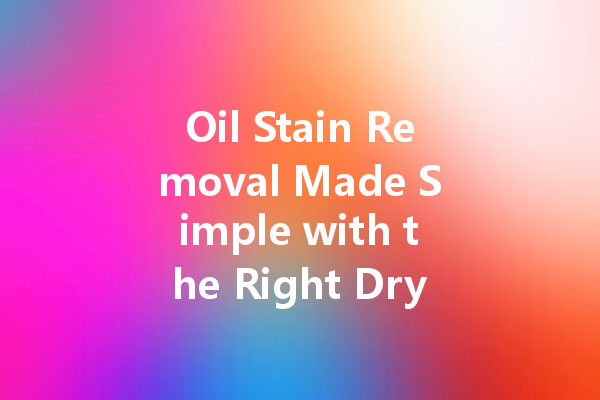Oil stains on clothing can be a nightmare for anyone, turning a favorite outfit into a frustrating reminder of an accidental spill. Fortunately, using the right dry cleaning agents can make oil stain removal simple and effective. This article explores the fundamentals of oil stain removal and offers practical tips for using dry cleaning products effectively.
Understanding Oil Stains
Oil stains come from various sources, including cooking oils, motor oils, and even makeup products. Unlike water-based stains, oil stains can penetrate fabrics deeply, making them challenging to remove. They often require specific treatments to break down the oil molecules and lift the stain without damaging the fabric.
Why Choose Dry Cleaning?
Dry cleaning uses chemical solvents instead of water to clean fabrics, which is particularly effective for oil stains. Traditional washing methods can sometimes set oil stains, making them even harder to remove. Dry cleaning agents are designed to dissolve oils and grease, allowing for a more thorough cleaning process.
Selecting the Right Dry Cleaning Agent
Choosing the correct dry cleaning product is crucial for effective oil stain removal. Here are some considerations:
Fabric Type
Different fabrics react differently to various cleaning agents. For instance, delicate fabrics like silk require a gentle solvent, while sturdier materials like cotton can handle more robust products. Always check the fabric care label before deciding on a cleaning solution.
Stain Type
Knowing what kind of oil caused the stain can help in choosing the right cleaning agent. For cooking oils, look for solvents specifically formulated to tackle kitchen stains. For automotive oils, industrial-grade cleaners might be more appropriate.
Preparing Your Fabric
Before using any dry cleaning agent, it’s essential to prepare the fabric:
Blot the Stain
Use a clean, dry cloth to blot the oil stain gently. This action helps remove excess oil from the fabric’s surface without rubbing it deeper into the fibers. Avoid using water at this stage, as it can set the stain further.
Test for Colorfastness
Always perform a patch test with any cleaning agent on an inconspicuous area of the fabric. This step ensures that the solvent won’t cause discoloration or damage before you treat the stain.

Applying the Dry Cleaning Agent
Follow these steps for effective application:
Apply the Product
Dab the dry cleaning solvent directly onto the stained area using a clean cloth or sponge. Be sure to use enough product to saturate the stain without over-saturating the fabric.
Let It Sit
Allow the dry cleaning agent to sit on the stain for the recommended time provided by the manufacturer. This contact time lets the solution break down the oil molecules, increasing the chances of successful removal.
Blot and Rinse
Blot the Area Again
After the recommended time has passed, use a dry cloth to blot the area. This step helps to lift the dissolved oil and cleaning agent from the fabric. Continue blotting until no more stain or cleaner is transferring to the cloth.
Rinse with Cold Water
If your fabric allows rinsing, run cold water over the treated area to remove any remaining cleaning agent. Be cautious not to rub the area, as this could reintroduce the stain into the fabric.
Professional Dry Cleaning Services
If the oil stain persists after DIY treatment, consider seeking professional help. Professional dry cleaners have access to stronger solvents and specialized equipment that can handle tough stains without damaging your clothing.
Frequency of Professional Cleaning
Regularly taking your garments to a professional dry cleaner can prevent the buildup of stains and ensure the longevity of your favorite pieces. For clothing often involved in activities prone to oil spills—such as cooking or working with machinery—consider scheduling regular cleanings.
Conclusion
Dealing with oil stains doesn’t have to be a stressful experience. By knowing how to choose the right dry cleaning agents and correctly applying them, you can effectively tackle oil stains and keep your clothes looking their best. Whether you attempt to remove the stain yourself or seek professional help, understanding the cleaning process puts you one step closer to a successful outcome. Say goodbye to those frustrating stains and enjoy your wardrobe to the fullest!
